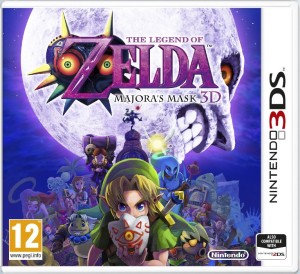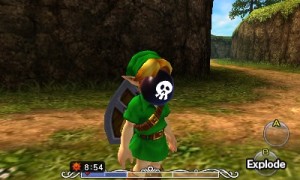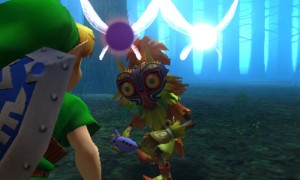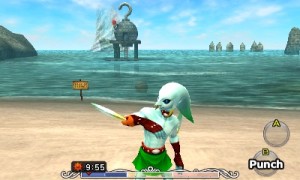“With every good deed, a child takes one step closer to adulthood.”
The Legend of Zelda: Majora’s Mask is, even after fifteen years, a brave experiment. It seems – at first glance – to be built to repel those who would have any interest in it, yet it has gathered a strong and devoted following since its original release on the Nintendo 64 in the year 2000. Zelda is a series that encourages exploration and building a relationship with the environments that Link finds himself in. Yet Majora’s Mask employs a countdown system that appears to rush players along, it chops down the number of proper dungeons to four, and it requires players to do and witness the same things over and over again. Surely this should be considered punishment, not pleasure.
Do not be fooled, because Majora’s Mask is still demonstrably a game about Link growing up and becoming a master of his environment, but he must do so in an unfamiliar way despite the eerie sensation of so many aesthetic and mechanical familiarities, which appropriately mirrors the player’s experience. For players who are willing to interact with the occasionally frustrating price of admission, the rewards are immensely gratifying and any frustration becomes a quaint necessity in retrospect.
To give context, Majora’s Mask is a direct sequel to the very well-received and influential Ocarina of Time which also received a remastered edition on the 3DS just under four years ago. Whereas Ocarina of Time did everything it could to take the sweet and simple coming of age stories as well as the swords and sorcery worlds of the previous 2D entries and transfer them to the related but ultimately separate genre of 3D action-adventure, Majora’s Mask had less pressure to be both a series and genre-defining event. Therefore it had the freedom to be a bold and thoughtful reaction to Ocarina of Time and as such, it is experimental and fresh and there is still no other Zelda entry quite like it.
As a remastered edition, the 3DS version of Majora’s Mask shines, even on systems unable to take advantage of the free-motion camera control and the improved glasses-free 3D technology. The design team not only made the user interface more quick and easy to manage by making great use of the touch screen in similar fashion to Ocarina of Time 3D, but it also made some small, but noticeable changes to some elements of the game itself. The changes will only be apparent to those most familiar with the ins and outs of Majora’s Mask – things like changed shop locations and different conditions to complete certain quests or obtain certain masks – but many of the changes make the game slightly more challenging and all lend themselves to the idea that the team that brought the game back to life were still aware of what made it so special in the first place.
At first, the hub world of Clock Town and the surrounding land of Termina appears tiny. After Link explores the town and completes the first dungeon, it is possible that an uninitiated player could become skeptical if he is not already. Everything seems so familiar, but with an annoying time limit and fewer dungeons. The cult appeal of the game might appear skin deep; after all, a giant angry moon and slightly more creepy music than Ocarina of Time provided could be nothing more than cheap aesthetic tricks.
And while Majora’s Mask greatest flaw is found in not properly setting the player on the right path to discovering the game’s sense of logic, once a player finds it, there is no turning back.
While technically the player will still need to defeat all the dungeons in order to defeat the final boss and while each dungeon is found in an area that only plays a slight variation to the series’ typical choice of biomes, if players familiar with the Zelda formula attempt to play Majora’s Mask like any other Zelda game, the mechanics will be nothing but a frustrating hindrance, an unnecessary timer on areas that they would be free to roam in other Zelda games.
The trick is realizing that Link still has all the time in the world.
This is the path to finding the game’s unique mood that pairs Link’s growing power with an equal sense of loneliness. The first step is paying attention to the Bomber’s Notebook (the quest log that has gained some significant upgrades in this remaster) and realizing that a countdown clock should not be equated to urgency. The NPCs are starting to panic, but Link is fine. Termina is Link’s Punxsutawney, Pennsylvania and Majora’s Mask is his Groundhog Day. The moment players slow down and start combing through their environment and interacting with characters, the more they will find the environments and characters will give back. Beyond small things like experimenting with how NPCs react to Link when he wears different masks, slowing down and enjoying the power of infinite time in a world in which nobody else has that luxury will let Link stumble upon context-dependent cutscenes which are only viewable in very specific scenarios, discover connections between people and places, and ultimately make him more powerful in his journey while providing players with a unique perspective.
This is how Majora’s Mask rewards those who thoroughly explore its world and how the game gives power and knowledge to players who start to become aware of the complex weaving of events and characters. Sure, one could blitz through all the dungeons, grumbling at the time constraints and wishing the game was more like Ocarina of Time, or one could spend carefully planned cycles exploring the world and improving Link’s efficiency, learning from mistakes and slowly gaining new items, new upgrades, new masks, and new techniques and ultimately becoming much better prepared for the dungeons.
After players start spending cycle after cycle focused on just one or a few tasks, the game’s world suddenly falls into place. Link’s approach to mastery has to change from what he is used to. In fact, that is the point. Three days can feel so short at first, but this is an illusion. Majora’s Mask is a game that views time laterally, not linearly, and Termina, its characters, and its obstacles take on a new form with this realization.
After this change in focus, the time constraint in a dungeon now becomes a worthy challenge. After spending many cycles outside of dungeons, players will become acutely aware of what they are capable of during the span of one. A dungeon is not something to stumble upon and to slowly work out like in many other Zelda games, it is an opponent to conquer. Even if a player spends a whole cycle in a dungeon only to have to restart at the last second, he will have a much easier time after he shakes off the frustration of his defeat. Even if he did not gain the item he wanted, he has gained knowledge and more of a mastery over his environment.
Majora’s Mask reiterates this mentality by including stray fairy quests in the dungeons to provide a second level of mastery. Termina is not a place to see things once. Sure, it is a little annoying that the guard stops Link from leaving Clock Town every time he is in a new cycle, but it is worth it for those times after a long, involved cycle when a player feels like he made a significant difference only to remember that practically nobody else is aware of his efforts. Majora’s Mask is about seeing the same thing with new eyes and once the player has put in the time to understand it emotionally and not just intellectually is when the game is at its most rewarding.
One special thing about Majora’s Mask is that even when everything appears to be wrapped up in a nice little package, the game makes sure to point out that nothing is ever that clean cut. There will still be injustice. There will still be loss. There will still be madness. There will still be chaos. Our history is part of us; all of it. It is a game that makes its claims about the importance of forgiveness, empathy, and love against a backdrop of unsettling darkness and thus turns what would otherwise be sentiment into a balanced and nuanced thesis. The more Majora’s Mask is explored, the more it returns these themes to the player.
In this vein and without spoiling the ending, the game’s credits make it clear which scenes are being missed because the player was not able or did not bother to obtain the necessary mask. Majora’s Mask is not only a great game to take the time to master, but it is a great game to revisit and replay with this newfound mastery.
None of this is to mention how fun it is to become familiar with all of Link’s various forms – from the eager, sad steps of the Deku Scrub to the proud and graceful swimming of Mikau – through mini-games and general exploration and how rewarding and entertaining it is to discover and follow all the stories that connect to each mask, no matter how trite or how complex.
However, the game is certainly not perfect. In addition to hiding its form from its players, it must be noted that while the nods to gameplay sections in Ocarina of Time fit thematically with both the narrative and mechanical structure of the game, it can still feel a little lazy and too reliant on Ocarina of Time. Also, while the Zelda series is excellent at creating great characters with rich histories and then knowing which details to provide and which to leave implicit or hidden, the incidental writing is standard video game below-average fare despite its sophisticated undercurrent. There is very good reason why Link does not talk and why there is extremely limited voice acting in the Zelda games: The series is always better when it remembers to show and not tell.
Also, while Majora’s Mask has a mostly wonderful soundtrack, there are some areas that disappointingly and unnecessarily reuse tracks from Ocarina of Time and that is not to mention that the Indigo-Go’s is definitely not the amazing band that the game tries to make them out to be. Expect some cringes surrounding those guys.
Majora’s Mask is a game that has an amazingly cohesive and complex inner logic and is an important, bold, and successful experiment in game design, but there is an important fact to clarify in the interest of consumer awareness. The feeling of losing progress, the illusion of the time constraint, and the constant repetition of events can be a very frustrating experience for new players or those who might have a difficult time breaking free from the Zelda formula mentality. Some will appreciate that Majora’s Mask lets players figure out its world and logic through failure, misunderstanding, reflection, and observation, but others might feel like jumping through the game’s hoops is not a worthy price of admission. Gamers must consider what sort of experiences they enjoy and understand that – while ported wonderfully to the handheld – Majora’s Mask is significantly larger than it appears and it is a game that takes time and patience to get to know. More than most games, Majora’s Mask is an experience that is best played away from the help of the internet and is definitely an experience that every devoted gamer should at least try, even if just to ultimately reject.
Full disclosure: the author was provided with a free copy of the game for review purposes. This review was based on the game played on 3DS XL hardware.



